12. Genetic Programming
Genetic programming is using a genetic algorithm for evolving programs/functions
The genotype is typically a tree structure representing the program/function phenotype
Genetic operators that work on the tree encoding are used
Ultimately, it’s a genetic algorithm that searches the space of programs/functions
12.1. Example Problem — Breast Cancer Identification
Consider the problem of determining if an individual has breast cancer [1]
ID |
Thickness |
Size |
Shape |
Bare Nuclei |
Mitosis |
Class |
|---|---|---|---|---|---|---|
1000025 |
5 |
1 |
1 |
1 |
1 |
Benign |
1002945 |
5 |
4 |
4 |
10 |
1 |
Benign |
1017122 |
8 |
10 |
10 |
10 |
1 |
Malignant |
1018099 |
1 |
1 |
1 |
10 |
1 |
Benign |
1041801 |
5 |
3 |
3 |
3 |
1 |
Malignant |
1043999 |
1 |
1 |
1 |
3 |
1 |
Benign |
1044572 |
8 |
7 |
5 |
9 |
4 |
Malignant |
… |
… |
… |
… |
… |
… |
… |
The goal is to build a classifier to determine if a patient has breast cancer based on the observations
What should the classifier be?
If size > 4 and (shape == 3 or shape == 5) then malignant else benign?If thickness > 4 and thickness < 9 then malignant else benign?If mitosis == 1 then malignant else benign?
It would take careful study and a deep understanding of the problem to build a classifier manually
However, AI and Machine Learning are often used to automate the process of building a classifier
The AI and Machine Learning would try to generalize trends that exists in the observations within the data
Unfortunately, most evolutionary computation algorithms are not particularly designed to find models like this
Often they are used for combinatorial or real number optimization
This is where genetic programming comes in
With the use of a clever representation, genetic programming optimizes programs/functions
12.2. Representation
S-expressions (symbolic expressions) are commonly used as the representation for genetic programming
S-expressions are used to represent nested instructions and data
These s-expressions are commonly visualized as tree structures

Three s-expressions shown as trees representing three different programs/functions. The left tree represents
the s-expression ((1.2 - x) * y), the centre tree represents ((length < 5.2) or not(red)), and the
right tree represents if((open and right_closed)) then(forward) else(turn_right). The light coloured nodes
represent operators while the darker nodes represent operands, both constants and variables.
Consider the above program/function for the breast cancer identification problem
If size > 4 and (shape == 3 or shape == 5) then malignant else benign?
If
TRUEmeans malignant andFALSEbenign, the program/function can be written as the following s-expression((size > 4) and ((shape == 3) or (shape == 5)))
This s-expression can also be represented as the following tree
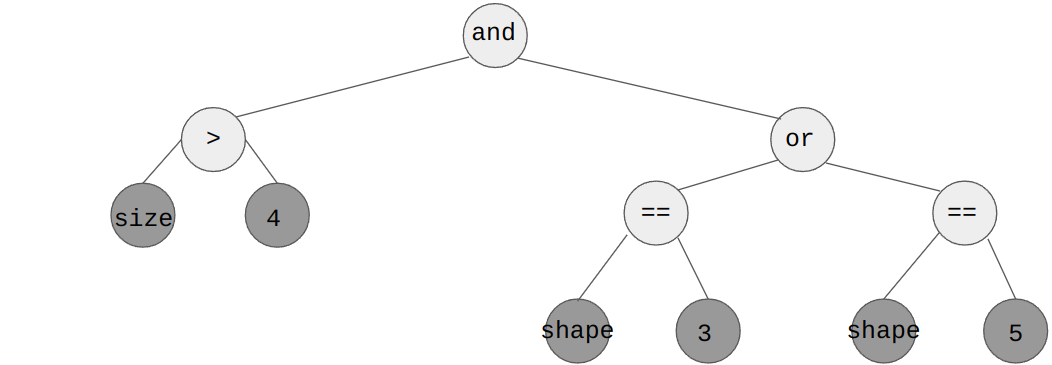
The program/function If size > 4 and (shape == 3 or shape == 5) then malignant else benign represented as a tree
structure.
12.2.1. Language
The set of available operators and operands use for creating and modifying the trees is called the language
The operators and operands are something that can be adjusted as needed
With the breast cancer example, the language could be a collection of arithmatic and boolean operators and operands
Operators
Binary Operators
\(+\)
\(-\)
\(\times\)
\(/\)
\(<\)
\(>\)
\(==\)
and
or
Unary Operators
\(sin\)
\(cos\)
\(e\)
not
Operands
Constants (e.g. \(4\), True, False)
Variables (e.g. size and shape)
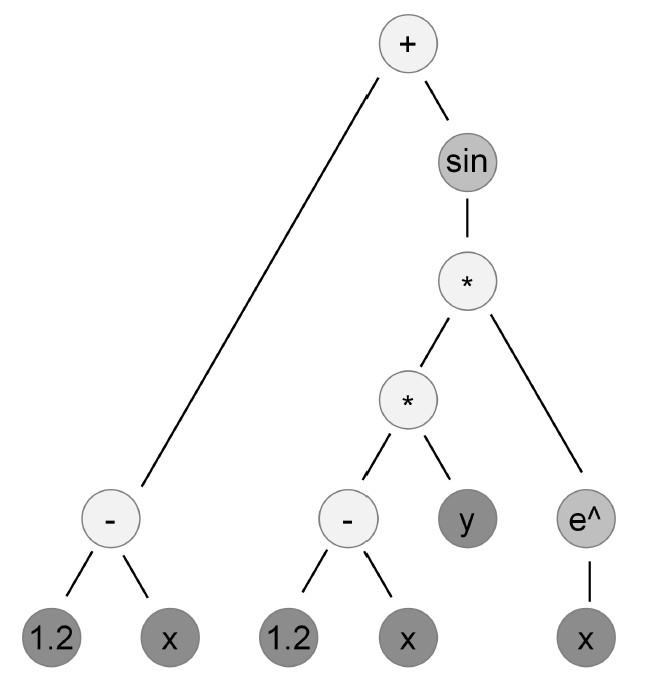
S-expression for the mathematical expression \((1.2 - x) + sin((1.2 - x) \times y \times e^{x})\). This tree contains arithmatic operators and operands (constants and variables).
When working with mathematical expressions, the language could be a collection of arithmatic operators and operands
Like the numerical operators and operands discussed above
12.2.2. Typed vs. Untyped
Notice that the mathematical expression example above only worked with numerical values
All the operators acted on numbers
All the operands, either constant or variable, would be numbers
However, the breast cancer example had multiple different types available
Some operators act on numbers to produce a number (e.g. \(+\))
Some operators act on numbers to produce a boolean (e.g. \(<\))
Some operators act on booleans to produce a boolean (e.g. and)
The operands may be either numbers or booleans
When using a language with only one type, like the mathematical expression, it is called untyped genetic programming
When using a language that has more than one type, it is called typed genetic programming
There is added complexity when working with typed genetic programming since the s-expressions must be admissible
Generating an s-expression that applies an operator to the wrong type would be a problem
For example,
(shape == 4) + 7is an inadmissible statement
With untyped genetic programming, this will not be a problem
Fortunately, most modern genetic programming systems will manage this complexity
12.3. Typical Genetic Programming Setup
A genetic programming algorithm is setup very similar to an ordinary genetic algorithm
Initialize a population
Evaluation
Selection
Genetic Operators
Termination
The key differences are around the tree representation
For example, the genetic operators must work with the trees
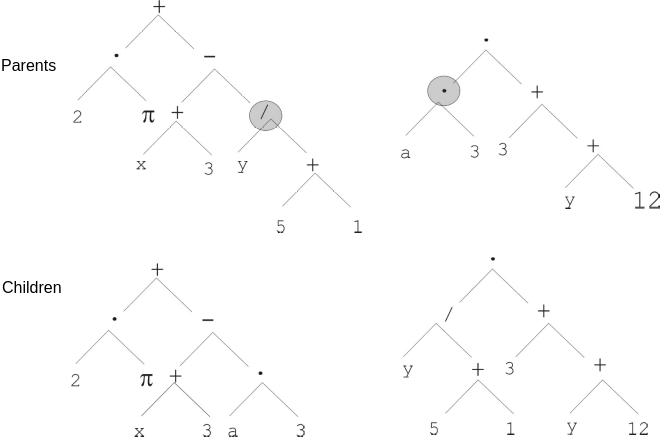
One point crossover on a tree structure. The two randomly selected subtrees are exchanged.
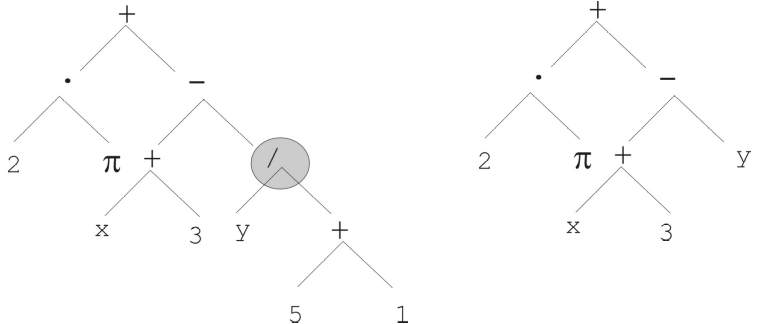
One point mutation on a tree structure. A randomly selected node in the tree is replaced with a randomly generated subtree. In this example, the subtree was replaced with a variable, but it could be been a more complex subtree.
Typically, for genetic programming, mutation rates are kept very low (less than 5%)
But ultimately, the value to use is a value that works well
Populations are also typically very large
12.4. Bloat
With genetic programming, during evolution, the average number of nodes in the trees increase quickly
And it is common that this happens with no significant improvement in fitness
This is problematic since
The trees take up more space
They take longer to evaluate
They tend to overfit and generalize poorly
The trees are difficult to interpret
The variation operators become less effective
There are three explanations for this phenomenon
Replication accuracy theory
Parents are selected for having a good fitness
Children with a function similar to their parents will also be relatively good
Larger trees are functionally impacted less by genetic operators
Thus, large and bloated trees are more likely to be similar to their parents
Removal bias theory
Useless subtrees with no meaningful function may exist within the tree
With larger trees, there is a higher chance to have useless subtrees
Applying genetic operators to useless subtrees has no impact on the fitness of the chromosome
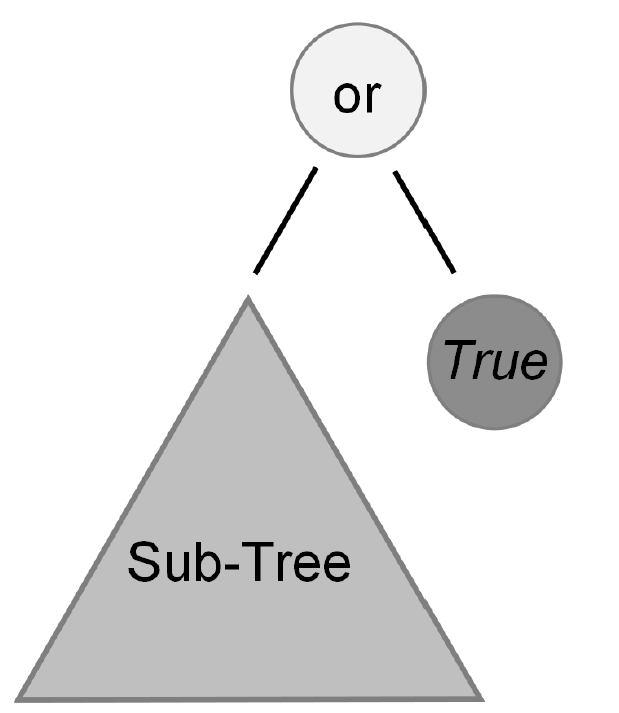
A tree that always evaluates to true, regardless of what is contained within the left subtree, which may be arbitrarily large.
Note
In evolutionary computation, “useless” information may not be useless over the course of evolution. This vestigial information within the chromosome may have been useful at some time, but became not represented in the phenotype.
It is also possible that this information reemerges as useful. For example, consider some subtree within the “useless” subtree in the above figure. Although it may not be expressed in the phenotype of this tree, it may end up expressed in some other tree’s phenotype via crossover.
Nature of program space theory
With a fixed language, there are more larger programs
The number of larger programs with a given function is greater than the number of short programs with the same function
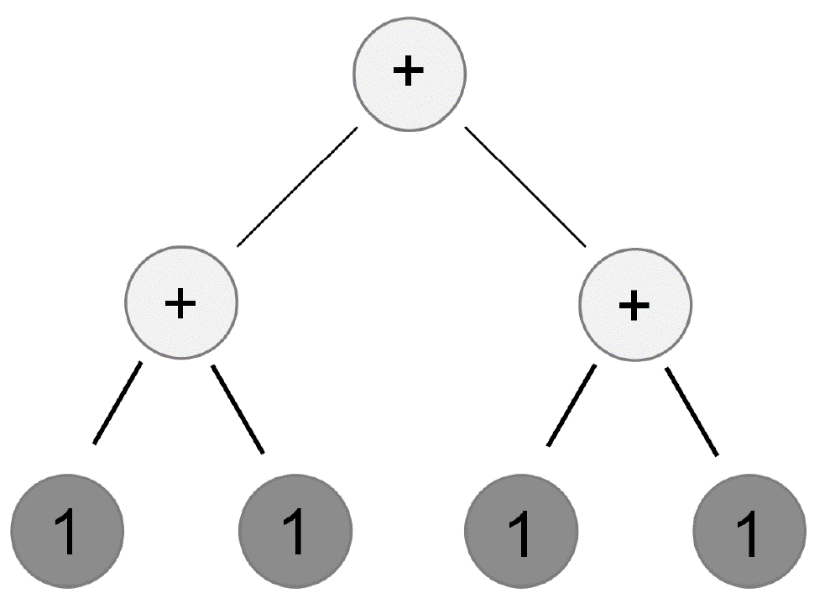
A tree with seven nodes that evaluates to 4. Consider the number of trees of size one that would also return 4 and then consider the number of trees of size three that would return 4.
Like everything, there is no right answer, but there are popular strategies to manage bloat
Set tree depth limits
Set tree node limits
Set special genetic operator rules
Add tree size to part of the fitness measure of the chromosomes
12.5. For Next Class
-
It is an evolutionary computation system/framework